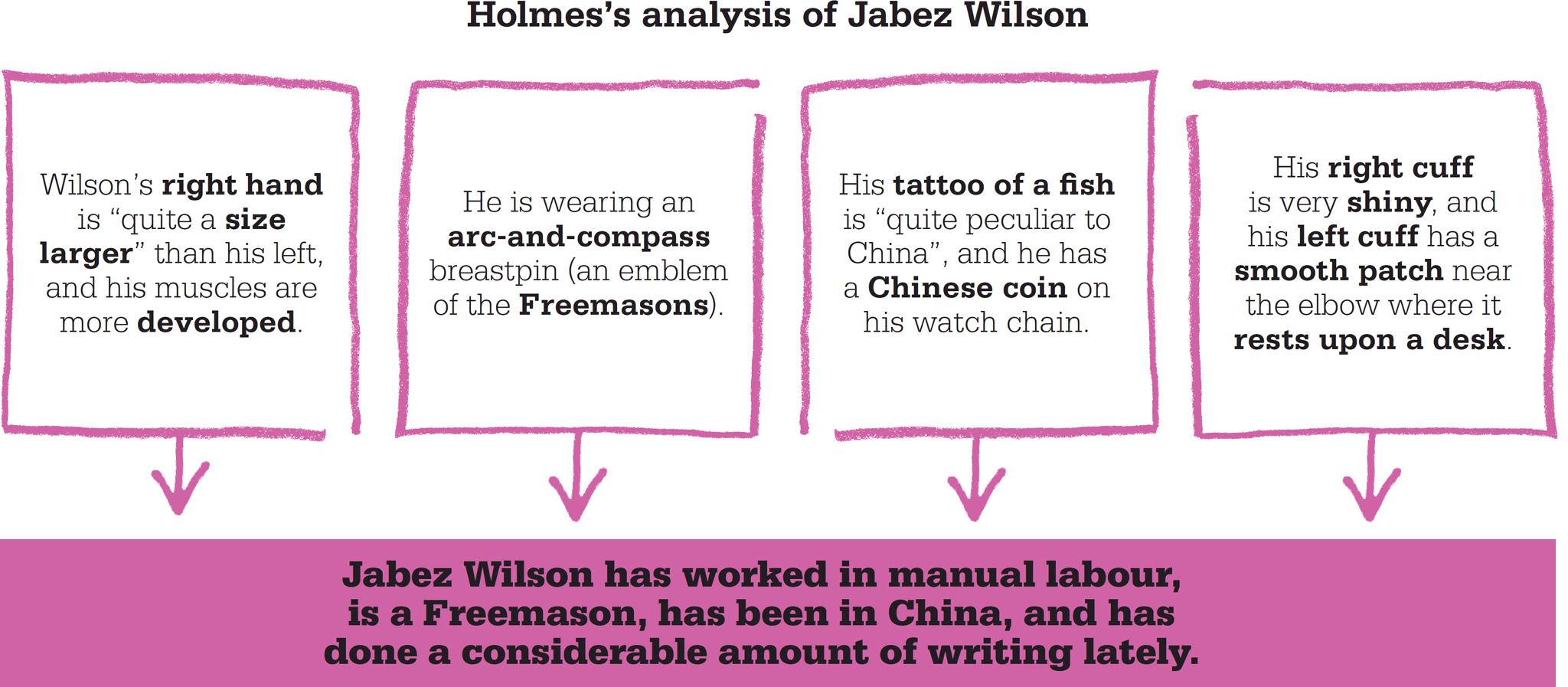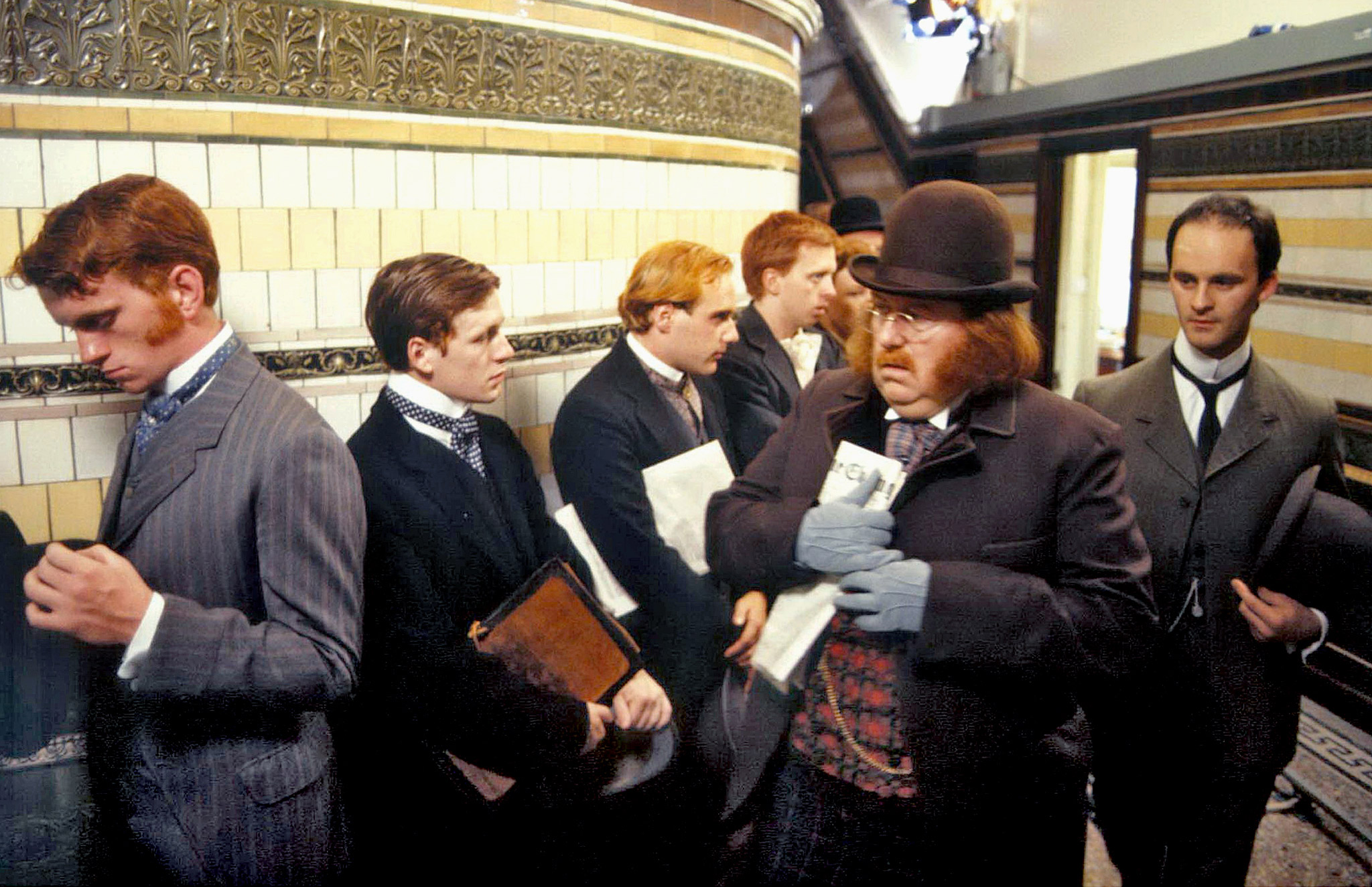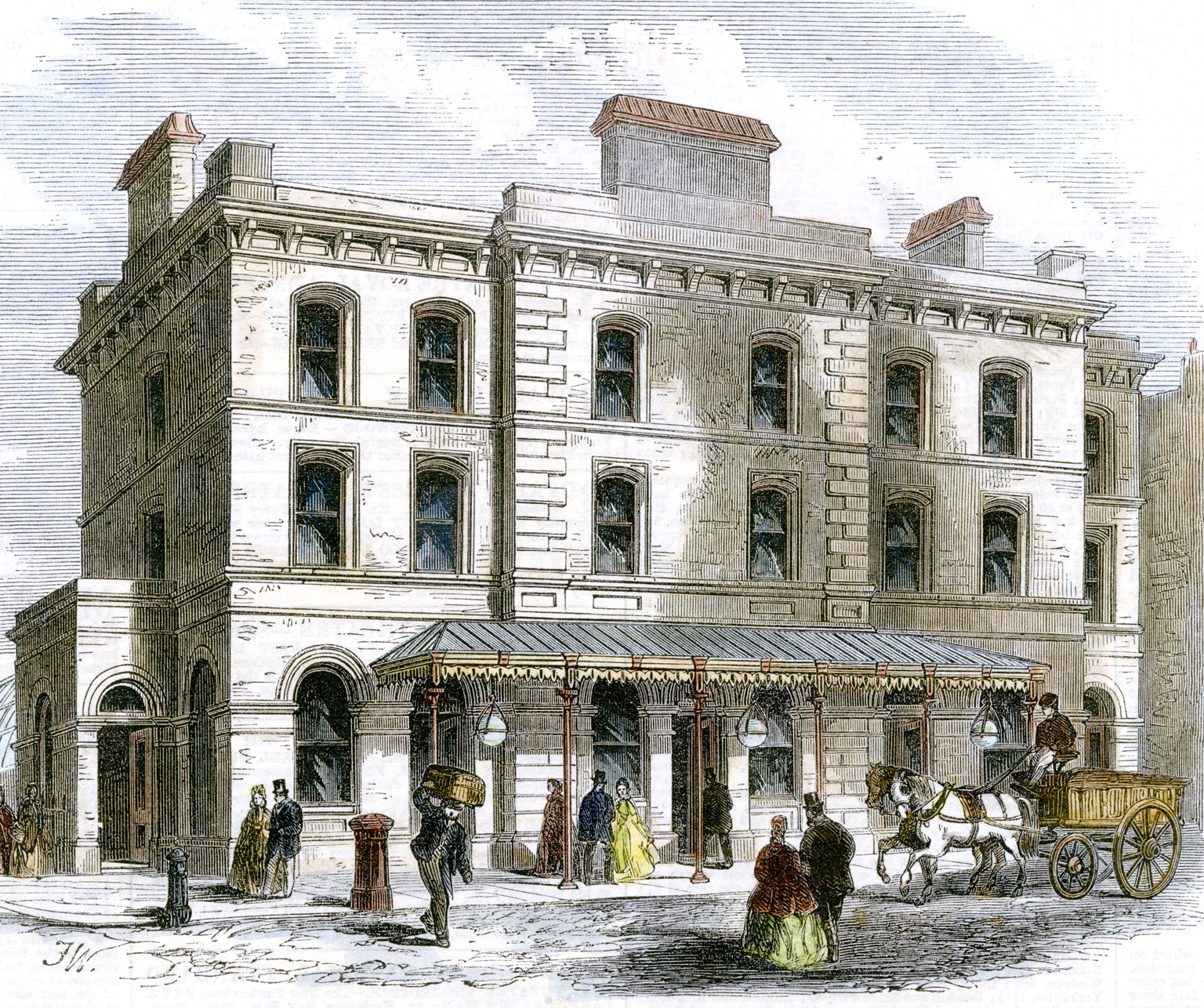
IN CONTEXT
Short story
UK: August 1891
The Adventures of Sherlock Holmes, 1892
Jabez Wilson Pawnbroker.
Vincent Spaulding Assistant at Jabez Wilson’s pawnshop.
Duncan Ross Man at the offices of the Red-Headed League.
Peter Jones Scotland Yard detective.
Mr. Merryweather Chairman of the City and Suburban Bank.
Although “The Red-Headed League” was written after “A Case of Identity”, it was the first of the two to be published in The Strand Magazine. Some Holmesian scholars have surmised that the Strand considered “The Red-Headed League” to be the better story, and wanted to establish the detective’s popularity as quickly as possible—it was certainly one of Conan Doyle’s favorites. But there is another, perhaps more likely reason: “The Red-Headed League” took just seven days to write, and Conan Doyle finished the first three short stories during April 1891. There is a good chance that “The Red-Headed League” and “A Case of Identity” were sent to the Strand together, resulting in a confusion about their intended order. Holmes’s reference in this story to “the very simple problem presented by Miss Mary Sutherland” (who appears in “A Case of Identity”) makes this mistake clear.
This is a story which focuses on gullibility and credulousness, and Conan Doyle brings attention to the bizarre, almost unbelievable nature of the case as a claim for its veracity. As Holmes remarks, “…for strange effects and extraordinary combinations we must go to life itself… always far more daring than any effort of the imagination.”

Commonplace beginnings
Watson calls on Holmes one day to find him deep in conversation with Jabez Wilson, a pawnbroker, who is a man florid of face, stout, and altogether an unremarkable example of “an average commonplace British tradesman”—that is, except for his mane of fiery red hair. Holmes swiftly realizes that Wilson is a Freemason. Conan Doyle was, at times, a member of this secret society, but here Holmes makes a pointed reference to “your order,” showing the detective’s aloofness from it, contrary to speculation that Holmes himself was a mason. Holmes also observes that Wilson has been doing a great deal of writing; and this remarkable case revolves around this mundane task.

Jabez Wilson (played by Roger Hammond in the 1984 Granada television production) is ushered through crowds of red-headed men.
Little sympathy
It is unlikely that Wilson, as a pawnbroker, would have aroused much sympathy in contemporary readers, as his trade is the equivalent of today’s thriving high-interest payday loan industry—a service to which poorer people were often obliged to turn, using jewelry and other valuables as security to borrow cash. Wilson himself remarks that his work is “mostly done of an evening, Mr. Holmes, especially Thursday and Friday evening, which is just before pay-day.” Nevertheless, Wilson tends not to leave his premises very often.
Wilson’s story
Wilson tells Holmes and Watson that two months previously, his new assistant, Vincent Spaulding, alerted him to an advertisement in the newspaper. It was placed by an organization called the Red-Headed League, based in the US in Lebanon, Pennsylvania, but with an office in (fictional) Pope’s Court, off Fleet Street. The League sought “red-headed men… above the age of twenty-one years” to apply for a post involving “purely nominal services,” at a weekly rate of £4. This amount was not to be sniffed at: Conan Doyle was only paid £25 for this story, even though he was soon able to command much higher fees. On the appointed day, says Wilson, Fleet Street was awash with men with red hair, and the thoroughfare looked like a “coster’s orange barrow”—costermongers being a kind of greengrocer seen all over London (the name comes from a medieval word for apple). The image is both potent and bizarre. At the offices of this League, Duncan Ross (his name is taken from the Italian, rosso, meaning red) delightedly offers Wilson first refusal on the job. His “test” of the pawnbroker’s hair is to tug on it with all his might to make sure it is not a wig; this is a masterpiece of theater, as is his lament that “I could tell you tales of cobbler’s wax [being used as a hair dye] which would disgust you with human nature.” It transpires that the work requires copying out by hand the whole of the Encyclopaedia Britannica from 10 am until 2 pm every weekday. Fortunately, these hours do not interfere with Wilson’s pawnbroking business. However, Wilson is told that if he leaves the office during the prescribed hours, he will instantly forfeit his new job.
"Your case is an exceedingly remarkable one, and I shall be happy to look into it."
Sherlock Holmes
THE BOYLSTON BANK ROBBERY

Although Holmes declares “The Red-Headed League” to be a ruse without precedent, the heist itself was not so original. In November 1869, a remarkably similar bank robbery took place in Boston, Massachusetts. Charley Bullard and Adam Worth (who may have been the inspiration for Moriarty) tunneled into the Boylston National Bank from a neighboring shop, then shipped their loot down the east coast to New York. The Boston Tribune called it “one of the most bold and successful robberies which has ever been perpetrated in this city.” For the six weeks prior to the theft, Bullard and Worth had operated the next-door premises as a hairdresser’s, all the while secretly tunneling into the bank’s vaults. Like the villains in this story, they had made the final moves over a weekend, so the losses were only discovered when the bank reopened the following Monday morning. The robbery’s full details were later uncovered by Pinkerton’s detectives, the same organization that would feature prominently in The Valley of Fear in 1914.
Double deception
Wilson’s assistant, Spaulding, began working for him a few months earlier. An eager employee, he was “willing to come for half wages, so as to learn the business.” Holmes notes that Wilson is fortunate to have an employee who “comes under the full market price.” But Spaulding disappears into the cellar of Wilson’s shop for hours at a time, supposedly developing photographs. It becomes clear to Holmes that the real “league” is between Spaulding and Ross; the sole aim of their elaborate ruse (which Conan Doyle returned to in “The Three Garridebs”) is to get Wilson out of his house, and keep him out, for some evidently nefarious purpose.
This unlikely tale sustains itself partly because it is so outlandish, and partly because it is hard to know what the two villains are cooking up. But Wilson’s own recognition that it all sounds too good to be true also goes some way to relieving the reader’s suspicions. In fact, to overcome his reservations, Wilson applies a reasoning rather like Holmes’s: sometimes the truth is stranger than fiction.
For eight weeks, Wilson copied from the book and the money kept coming. Then, on the morning of his visit to 221B Baker Street, he had arrived at Pope’s Court to find a sign pinned to the door, reading: “The Red Headed-League is dissolved, Oct 9, 1890.” Wilson asked around, and discovered that Ross had also been going by the alias “William Morris.” Wilson was given an address in King Edward Street, near St. Paul’s: “I started off, Mr. Holmes, but when I got to that address it was a manufactory of artificial knee-caps, and no one in it had ever heard of either Mr. William Morris, or Mr. Duncan Ross.”

Aldersgate Street Station, one of the original Underground stations on London’s Metropolitan Railway, opened in 1865. This engraving appeared in The London Illustrated News in 1866.
The scene of the crime
Although Holmes declares the case to be “quite a three-pipe problem”—meaning that he would usually take the time to ponder and let his mind wander through all the elements of the mystery—he immediately recognizes Spaulding from Wilson’s description, as the telltale white acid-splash scar on his forehead is so distinctive (the alert reader in 1891 would know that acid was used by coin counterfeiters). “Spaulding” is in fact John Clay, “one of the coolest and most daring criminals in London.” It remains only for Holmes to visit Wilson’s shop and find out what Clay is up to.
Holmes and Watson’s journey to Aldersgate Street Station (now Barbican Station) on the oldest stretch of the London Underground network is the only recorded instance of them traveling by Tube: a remarkable fact, since there was (and still is) a Tube station at the end of Baker Street. “Saxe-Coburg Square,” which Wilson gives as the location of his shop, does not actually exist. It has a royal name, and Conan Doyle might have been inspired by Bloomsbury’s Mecklenburgh Square—named after the wife of George III—near Holmes’s first London lodgings in Montague Street. However, while that square is fairly grand, the fictional Saxe-Coburg Square is “a poky, little, shabby-genteel place, where four lines of dingy two-storied brick houses looked out into a small railed-in enclosure.”
On arrival at Wilson’s shop, and certain that Clay will not recognize him, Holmes knocks at the door. Clay responds curtly to his request for directions to the Strand. In truth, Holmes has only summoned him in order to get a look at his trouser-legs. Sure enough, the knees are dusty and worn—proof that something has been going on in the cellar. Holmes has already concluded that the only possible explanation is that Clay is digging a tunnel, so he raps his stick on the pavement outside to test for a hollow sound, but there is none. However, walking around the corner, Holmes realizes that the shop backs on to the Coburg branch of the City and Suburban Bank in the much finer grand parade of Farringdon Street.
Incidentally, as Holmes and Watson scout the scene, Holmes remarks, “It is a hobby of mine to have an exact knowledge of London.” Conan Doyle would have done well to do the same, as his descriptions of London are often riddled with inconsistencies. For instance, it does not make sense that Holmes and Watson go to Aldersgate Street Station to walk as far as Farringdon Street. It is also odd that St. Bartholomew’s hospital, which is just around the corner, is not mentioned, since this is where Holmes and Watson first met in A Study in Scarlet.
"We are spies in an enemy’s country. We know something of Saxe-Coburg Square. Let us now explore the parts which lie behind it."
Sherlock Holmes
Time to “play”
Holmes now has all the pieces of the puzzle he needs, and he and Watson continue to St. James’s Hall in the West End to hear the real-life Spanish violinist and composer Pablo Sarasate. Watson—still in the dark about the case—muses on the way Holmes’s behavior fluctuates from “extreme languor to devouring energy.” Building on the atmospherics in The Sign of Four, this taps into 19th-century anxieties about the unconscious mind and can also be read as a reference to the idea of the “double life,” a major literary trend of the time featuring in novels such as Oscar Wilde’s The Picture of Dorian Gray (1890) and Robert Louis Stevenson’s Strange Case of Dr. Jekyll and Mr. Hyde (1886). Holmes’s “dual nature” also has roots in Detective C. Auguste Dupin’s “bi-part soul” in Edgar Allan Poe’s “The Murders in the Rue Morgue” (1841). But perhaps Holmes is simply treating his brain as a machine, using a little music to stay relaxed—there is nothing to be done now until nightfall.
"A considerable crime is in contemplation. I have every reason to believe that we shall be in time to stop it."
Sherlock Holmes

The “real” John Clay is described by Scotland Yard’s Peter Jones as a “murderer, thief, smasher, and forger.” As his alias, Vincent Spaulding, he appears at first to be quite the opposite.
Caught in the act
Later that evening, Holmes and Watson meet at 221B, along with Peter Jones, “the official police agent,” and Mr. Merryweather, head of the City and Suburban Bank. Jones reassures Merryweather by remarking on “that business of the Sholto murder and the Agra treasure” (events in The Sign of Four), showing that Holmes has become recognized at Scotland Yard.
The group heads to Farringdon Street and the vaults of the Coburg branch of the City and Suburban Bank, which is temporarily housing £30,000 worth of gold “napoleon” coins borrowed from the Bank of France. Merryweather strikes the flagstone floor with his stick and declares that “it sounds quite hollow.” After a long wait, with Watson’s army revolver cocked and the tension palpable, a “lurid spark” appears through a chink in the floor. When the two villains appear from their tunnel, Holmes collars Clay, while “Ross/Morris”—whose real name turns out to be Archie—tries to escape the way he came, but is arrested by the police officers waiting outside Wilson’s shop.

This illustration, entitled “It’s no use, John Clay… you have no chance at all,” from The Strand Magazine, 1891, shows Holmes capturing Clay as he emerges from the tunnel.
Deep thinker
Back at 221B, Holmes remarks to Watson that the case has provided a welcome break from the tedium of everyday life: “It saved me from ennui. Alas! I already feel it closing in upon me.” In the 1890s the word ennui (French for “boredom”) carried connotations of decadent, fin de siècle world-weariness, recalling the effete heroes of Oscar Wilde, J. K. Huysmans, and others. It is also reminiscent of the 19th-century French poet Charles Baudelaire, whose book Le Spleen de Paris (published posthumously in 1869) helped establish the appeal of affectedly melancholic boredom.
Holmes’s final remark, a slightly misquoted aphorism from the French novelist Gustave Flaubert (“the man is nothing, the work everything”), suggests that the literary allusions might not have been accidental. It is clear that while the Holmes who appears in “The Red-Headed League” is relatively consistent with the Holmes of The Sign of Four, there has been a marked shift in his character since A Study in Scarlet. In that first story, Watson remarked of Holmes, “Of contemporary literature, philosophy and politics he appeared to know next to nothing.” Yet earlier in “The Red-Headed League,” when Holmes explained how he had deduced that Wilson was a Freemason, the pawnbroker said bluntly, “I thought at first that you had done something clever, but I see that there is nothing in it after all.” Holmes’s erudite response to his client, a line from the Roman author Tacitus, not only displays his learning but would work equally well as a motto to this strange case: “Omne ignotum pro magnifico,” which translates as “that which is most mysterious always seems most magnificent.”
JOHN CLAY
A young man “at the head of his profession,” John Clay is a worthy adversary for Holmes, and the detective holds a certain admiration for Clay’s cunning and the challenge he presents. Although Clay does not appear anywhere else in the canon, it seems that Holmes has met him before. After declining a reward at the end of this case, Holmes states that “I have had one or two little scores of my own to settle with Mr. John Clay… I am amply repaid by having had an experience which is in many ways unique.” In anticipation of the later villain Moriarty, the aristocrat of crime, Clay is the grandson of a royal duke. He was educated at Eton—one of Britain’s most elite private schools—and Oxford University, where some Holmesian scholars believe the detective studied. Clay’s snobbery is clear in his actions toward Jones, the Scotland Yard policeman—he insists that the officer call him “sir,” and demands not to be touched by his “filthy hands” as he is handcuffed.
